Hyssop (blue hypericum, agastahis)
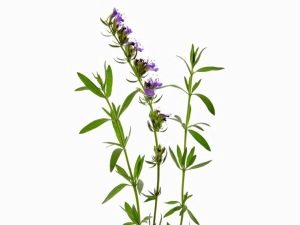
Hyssop belongs to the Mint tribe from the Yasnotkov family. Other names for the plant are blue St. John's wort, agastahis or bee grass. The plant has a rather pungent odour.
Title in other languages:
- lat. Hyssopus officinalis;
- English Hyssop;
- fr. Hysope.

Appearance
It grows in the form of grass or semi-shrub, it can reach up to 0.6 m in length. It has oblong, whole-edged leaves of dark green color. Their length is several cm. They are located opposite each other on the stem, almost sessile. They have a pleasant spicy, refreshing mint smell and a slightly bitter aftertaste.

The stem is tetrahedral.
Irregular flowers closer to the top are white, pink or cabal blue, form inflorescences. In the axils of the leaflets there are smaller flowers of purple, lilac, pink or even milky color.
Flowering occurs from early summer to early autumn. The hyssop fruits break up into egg-shaped nuts of a brown shade. There are four such nuts, each also has four faces.


Kinds
The most commonly used as an ornamental and medicinal plant is hyssop officinalis.

Previously, hyssop numbered over fifty species. At the moment, there are about seven species left.


Anise hyssop (Agastache anisata) has delicate large ovate-pointed serrated leaves, pubescent below.Its inflorescences are from lilac to red-violet. Flower candles are up to 20 cm high. The smell of leaves resembles anise and licorice.
Lemon hyssop (Mexican agastahis or Mexican mint - Agastache mexikana) has an aniseed aroma with hints of lemon. Its leaves are serrated and narrower than those of anise. It has bright red-purple flowers.


Where does it grow?
Hyssop loves warm climes, despite the fact that he can withstand even harsh conditions. Most species grow in the countries of the Mediterranean Sea, as well as in Asia. In Russia, it occurs mainly in the middle and southern latitudes. It can grow both in the European territory of the country, and closer to the Caucasus Mountains. Also often blue St. John's wort can be found closer to the south of Western Siberia.
It grows mainly in the steppe zone, on hills with dry soil, on mountain slopes. Tolerates drought well.
If growing hyssop in the garden, it is recommended to plant it in sunny areas with loose soil. In conditions of high humidity and closer to swamps, it grows poorly. Without proper supervision, it immediately runs wild.

spice making method
The blue St. John's wort has a tart-spicy taste and a pleasant smell. Fresh leaves are used as a spice, for this they are simply finely chopped. Also, the plant is often dried, ground and then used as a spice in combination with other seasonings and spices.
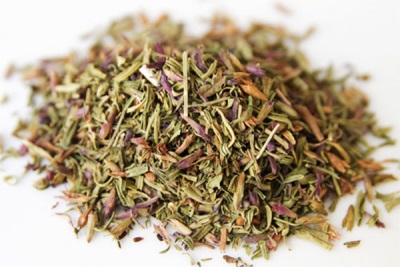
Peculiarities
The plant exudes a strong aroma throughout the flowering period. Its fruits are often confused with seeds. The seeds are so small that there are about a thousand of them per 1 gram. They can be stored for several years.
Hyssop is a good honey plant, hence the name of the plant "bee grass".Bees are very fond of collecting pollen and nectar from it, so it is convenient to grow it near a bee hive or apiary.


Characteristics
Hyssop has the following characteristics:
- used in cooking;
- used in folk medicine;
- unpretentious to growing conditions;
- drought tolerant;
- endures cold;
- often grown for ornamental purposes.

Nutritional value and calories
Nutritional value and calorie content per 100 grams of product
| Squirrels | Fats | Carbohydrates | calories |
|---|---|---|---|
| 3.9 gr. | 0.6 gr. | 0.2 gr. | 21 cal. |
You can find out more useful information by watching the video.
Chemical composition
Hyssop contains the following substances:
- isopinocamphone;
- carvacrol;
- hesperidin;
- diosmin;
- vitamin C;
- glycosides;
- ursolic acid;
- essential oils;
- terpenic acids;
- tannins;
- bitterness.
The essential oil of the herb also contains many useful substances.
Beneficial features
Hyssop has a number of useful properties:
- used in folk and traditional medicine;
- has an anti-inflammatory effect;
- helps reduce sweating;
- removes worms from the intestines;
- helps improve digestion;
- has excellent antibacterial properties.


Harm
Undesirable consequences are also possible when using hyssop:
- diarrhea;
- spasms.
Such effects can occur with an overdose, as well as in the presence of contraindications for use.
Contraindications
Do not use hyssop in the following cases:
- in the presence of kidney disease;
- during pregnancy and lactation;
- in the presence of epilepsy;
- with individual intolerance.
People with heart disease and high blood pressure should take drugs or products containing hyssop with caution.Due to the intake in large doses, the plant causes spasms, therefore, it is strictly forbidden to use it by pregnant women and patients with epilepsy.
Nursing women are prohibited from taking hyssop due to the fact that the plant contains substances that can reduce lactation or stop it altogether.

Oil
Hyssop oil is obtained from the leaves using a steam distillation method. The essential oil has a yellowish-green hue. It is a flowing thin liquid with a sweetish aroma.
Oil is used to improve overall well-being, mood. It increases the stamina of the body and has antiseptic properties. Often used in aromatherapy to calm the nervous system. The oil also increases blood pressure, so it is recommended for hypotensive patients.
In addition to being an excellent antibacterial agent, blue St. John's wort oil helps reduce sweating. It is used by many manufacturers of perfumes and cosmetics.

Juice
The juice of the plant is diluted with water in equal proportions and used as a natural deodorant.
Application
In cooking
Due to its unique aroma, hyssop is often used in cooking:
- it is used fresh in salads;
- it is in perfect harmony with vegetables;
- it is served with bean dishes;
- as a spice it is used for meat, fish, poultry and offal;
- the herb is added to teas and a variety of drinks (including alcoholic ones);
- used in fillings for both sweet and savory dishes;
- as a spice, the plant is used in soups, snacks, desserts;
- added to marinades for vegetables and canned food;
- the plant is used in combination with other spices, complementing and emphasizing their taste.
The taste of blue St. John's wort is slightly tart, but with spicy notes. It is cut fresh in salads along with other herbs, and also consumed with cottage cheese.
In crushed and dried form, hyssop will perfectly emphasize the taste of almost any dish. In the preparation of pickles, it also acts as an important spice.
In the production of alcoholic beverages, the plant is sometimes actively used, for example, in liqueurs. Due to its low calorie content, it is also suitable for dietary dishes.
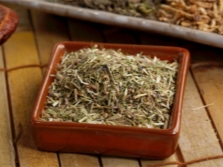


Due to the rather pungent smell, with all the desire to add hyssop in large quantities to the dish, it is impossible.
There are norms according to which it is recommended to add no more than half a gram of dried hyssop greens to soups. In second courses, marinades and sauces, even less should be added.
Often hyssop is used as an additive to black tea. In combination with honey, the drink will have a divine taste.

Hyssop goes well with other herbs, so you can safely add it to salads without fear of experimentation.
You can make tea from blue St. John's wort, which is also good for medicinal purposes. To do this, take a couple of pinches of grass. They are poured with several cups of boiling water, insisted and filtered. And then consumed with honey 3 times a day.
A few leaves of the plant should be added when preparing poultry dishes, for example, when stewing and baking. The dish will have an unforgettable aroma.

In medicine
Hyssop is used in herbal medicine, as well as in folk medicine.
Its medicinal properties are used in the following cases:
- as an expectorant for coughs, pneumonia, bronchitis;
- for the treatment of diseases of the gastrointestinal tract;
- to improve appetite;
- to reduce bloating;
- as a diaphoretic for colds;
- as a sedative;
- for fast healing of wounds;
- with bruises and hematomas (as compresses);
- as an infusion for diseases of the teeth or oral cavity;
- to soften the skin.
According to its medicinal effect, hyssop is close to sage. It has a diuretic effect and removes excess fluid from the body. The plant has a powerful anti-inflammatory effect. Decoctions from it are effective for conjunctivitis. Hyssop-based lotions help hematomas resolve faster. The plant also has analgesic properties. St. John's wort herb compresses help relieve pain from wounds or cuts.

When losing weight
Hyssop has a slight laxative and diuretic effect, therefore it is used to remove excess fluid from the body. This contributes to a slight weight loss and cleansing of the body.
At home
The domestic use of the plant is quite diverse:
- it is grown for decorative purposes;
- used in cooking to flavor dishes;
- used in herbal medicine;
- used in aromatherapy;
- oil is added to the bath to tone the skin and calm the nervous system;
- used in the alcoholic beverage industry;
- added to perfume compositions;
- used as honey plant.


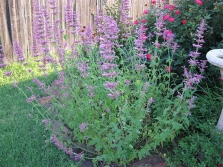
In addition, due to its pleasant smell and disinfectant properties, hyssop was previously used as a kind of air freshener, hanging grass in rooms under the ceiling.
cultivation
- It grows even in harsh winters and is undemanding to environmental conditions if you intend to grow it in the garden. Soil is the main factor for the growth of hyssop - it must be fertile.
- It can grow in the same area for years. The area where it is planned to land should receive a lot of sunlight.The plant is propagated by division, seeds and cuttings.
- With seed propagation, planting should be carried out already in early spring. Between plants there should be at least 0.5 m, and between rows - up to 0.2 m. Planting is carried out at a shallow depth, up to 1 cm. In a couple of weeks, sprouts will appear.
- Seeds can be planted previously in greenhouses, and then seedlings can be transferred to the soil.
- Cuttings can be rooted in summer and spring. However, reproduction in this way is not used very often. The division is carried out in early spring, it will allow young shoots to develop better.
- Sometimes blue St. John's wort is grown even at room conditions right in pots.
- If the plant is used as a spice, then the collection must be carried out during all the summer months. For medicinal purposes, the upper part of the stem is used. It is cut before flowering and dried.
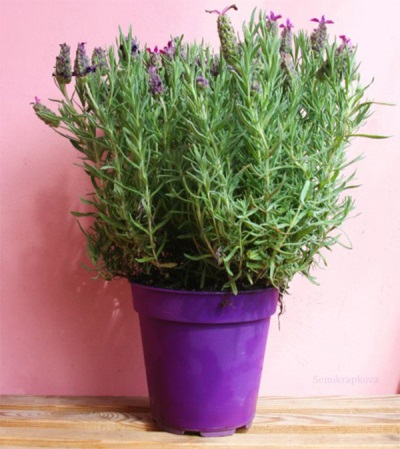
Interesting Facts
- Hyssop is mentioned in the Bible. It is believed that the Jews dipped the plant in holy water and sprinkled the believers with it. This was considered a kind of rite of purification.
- In Russia, it began to be grown on the territories of monasteries.
- In the Middle Ages, the plant was used in winemaking.
- It is said that Hippocrates himself used hyssop for medicinal purposes.
- In ancient times, it was believed that blue St. John's wort has truly magical properties. The herb was added to smoking mixtures to exorcise evil spirits. They believed that the plant acquires its energy after drying, getting rid of moisture. Hyssop was used to purify a person from evil thoughts.


















Hyssop is very handsome, and also useful! I want the same borders from it as here in the photo!